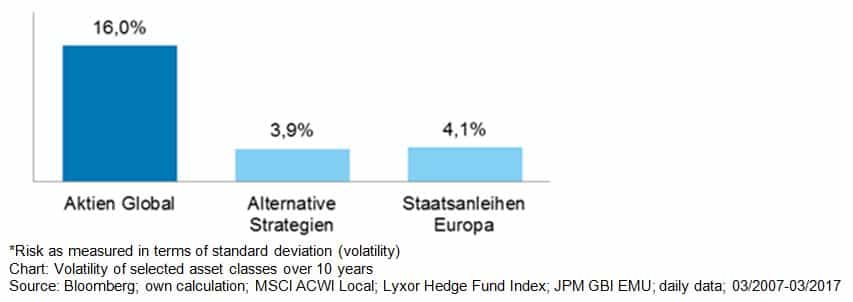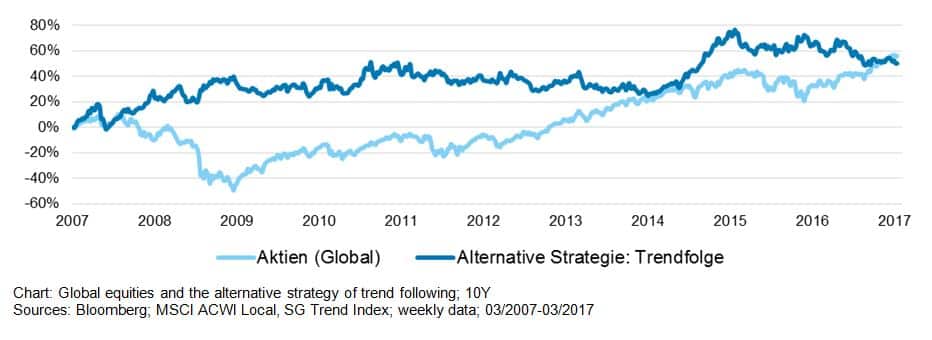
Christian Süttinger, Senior Fund Manager
Author: Christian Süttinger
Senior Fund Manager Multi Asset Management
In the USA, gradually rising interest rates have already become reality. In Europe and in another large economic area, i.e. Japan, the subdued economic development has prevented interest rates from increasing to date. The European Central Bank manages interest rates in such a way as to support the economic upswing and the cohesion of the Eurozone.
The search for alternatives amid low or rising interest rates
In order to avoid inflation, the rates in Europe could be raised gradually. In such an environment, the expected return to be gained from bonds and securities with bond-like features is limited. Indeed, capital losses are possible over the long term. Investors would therefore shift their focus on investments with higher risk such as equities or emerging markets assets.
Alternative strategies provide the opportunity of basing one’s portfolio on independent pillars. The independence (i.e. low correlation) of performance in comparison with equities or bonds makes alternative strategies its own, interesting asset class. For example, the risk associated with this asset class has been clearly below that of equities in the past ten years. The most important representatives of the asset class in particular, i.e. “trend following”, “global macro”, and “long/short equity”, are a good investment also in times of rising interest rates.
This chart illustrates the risk* of alternative strategies as compared to equities:

The volatility of equities over a period of ten years amounts to 16.0%, while the referential percentage for bonds is 4.1%, and for alternative strategies 3.9%. Low volatility means a smaller fluctuation range and thus a higher degree of stability.
What are typical alternative investment strategies?
The strategy of Trend Following (“Commodity Trading Advisors – CTA Managed Futures“ – for more information, please wait for the upcoming part 2 of this blog series) uses software in an attempt to identify trends across financial markets. These could be rising trends as well as falling ones. What market forms the trend is not that important. Trend followers therefore do not only invest on stock exchanges, but also on bond, commodity, and currency exchanges. CTAs can earn a return on falling prices as well. Alternative strategies can always invest both in rising prices (“long”) and in falling ones (“short”), which traditional investment strategies cannot do.

The Global Macro strategy constructs a broadly diversified portfolio from different asset classes on the basis of thorough research and the experience of the fund management team. This approach also allows for investments in rising and falling prices.
Long/Short-Equity analyses individual companies in an attempt to identify winners and losers and invest in both. Part of the strategy involves “long” positioning (winners) and “short” positioning (losers). Both sides are independent of each other, which is why the overall strategy is stable. Here, rising interest rates cause an increasing impact of capital costs on company balance sheets. This makes it easier to differentiate between robust and weak business models.
Imagine for example you could borrow money at 0% – even if you were to live way beyond your means, this would have little effect on your financial situation. It would only be at a rate of, say, 6% that the financial effect would be enormous. This rational easily translates into the corporate sector. High interest rates also mean rising costs for a company. This means that in times of high interest rates, it becomes clear which company can absorb them due to its robust business model and which cannot do so.
Four criteria that have to be met for an investment strategy to be considered alternative:
- The potential of producing return also amid low or rising interest rates
- Lower risk than equities
- Performance largely independent of equities and bonds
- The option of also benefiting from falling prices
The main difference between alternative investment funds and traditional funds is the fact that alternative strategies allow investors to also benefit from falling prices. Given that on the markets, prices tend to rise and fall over longer periods of time and alternative investments can gain from both, the resulting overall stability of the strategy is closer to that of bonds than to that of equities.
Conclusion
Alternative strategies offer stable performance and diversification, especially during times of rising interest rates. In the next two articles, we will describe the available strategies in more detail.
The author:
Christian Süttinger has been with ERSTE-SPARINVEST KAG since 2002. He is Senior Fund Manager in the Multi-Asset-Management team for alternative strategies. He holds a MSc (Business Administration) from the Vienna University of Economics and Business Administration and has been Chartered Financial Analyst and Chartered Alternative Investment Analyst since 2009 and 2010, respectively.
Legal disclaimer
This document is an advertisement. Unless indicated otherwise, source: Erste Asset Management GmbH. The language of communication of the sales offices is German and the languages of communication of the Management Company also include English.
The prospectus for UCITS funds (including any amendments) is prepared and published in accordance with the provisions of the InvFG 2011 as amended. Information for Investors pursuant to § 21 AIFMG is prepared for the alternative investment funds (AIF) administered by Erste Asset Management GmbH pursuant to the provisions of the AIFMG in conjunction with the InvFG 2011.
The currently valid versions of the prospectus, the Information for Investors pursuant to § 21 AIFMG, and the key information document can be found on the website www.erste-am.com under “Mandatory publications” and can be obtained free of charge by interested investors at the offices of the Management Company and at the offices of the depositary bank. The exact date of the most recent publication of the prospectus, the languages in which the fund prospectus or the Information for Investors pursuant to Art 21 AIFMG and the key information document are available, and any other locations where the documents can be obtained are indicated on the website www.erste-am.com. A summary of the investor rights is available in German and English on the website www.erste-am.com/investor-rights and can also be obtained from the Management Company.
The Management Company can decide to suspend the provisions it has taken for the sale of unit certificates in other countries in accordance with the regulatory requirements.
Note: You are about to purchase a product that may be difficult to understand. We recommend that you read the indicated fund documents before making an investment decision. In addition to the locations listed above, you can obtain these documents free of charge at the offices of the referring Sparkassen bank and the offices of Erste Bank der oesterreichischen Sparkassen AG. You can also access these documents electronically at www.erste-am.com.
Our analyses and conclusions are general in nature and do not take into account the individual characteristics of our investors in terms of earnings, taxation, experience and knowledge, investment objective, financial position, capacity for loss, and risk tolerance. Past performance is not a reliable indicator of the future performance of a fund.
Please note: Investments in securities entail risks in addition to the opportunities presented here. The value of units and their earnings can rise and fall. Changes in exchange rates can also have a positive or negative effect on the value of an investment. For this reason, you may receive less than your originally invested amount when you redeem your units. Persons who are interested in purchasing units in investment funds are advised to read the current fund prospectus(es) and the Information for Investors pursuant to § 21 AIFMG, especially the risk notices they contain, before making an investment decision. If the fund currency is different than the investor’s home currency, changes in the relevant exchange rate can positively or negatively influence the value of the investment and the amount of the costs associated with the fund in the home currency.
We are not permitted to directly or indirectly offer, sell, transfer, or deliver this financial product to natural or legal persons whose place of residence or domicile is located in a country where this is legally prohibited. In this case, we may not provide any product information, either.
Please consult the corresponding information in the fund prospectus and the Information for Investors pursuant to § 21 AIFMG for restrictions on the sale of the fund to American or Russian citizens.
It is expressly noted that this communication does not provide any investment recommendations, but only expresses our current market assessment. Thus, this communication is not a substitute for investment advice.
This document does not represent a sales activity of the Management Company and therefore may not be construed as an offer for the purchase or sale of financial or investment instruments.
Erste Asset Management GmbH is affiliated with the Erste Bank and austrian Sparkassen banks.
Please also read the “Information about us and our securities services” published by your bank.


